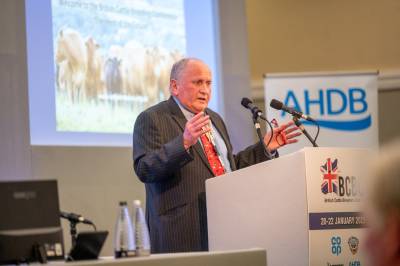Summary

Looking back to our roots, the British Cattle Breeders Club was founded by the late Sir John Hammond in 1946. Its aim then, as now, was to provide a forum for exchange between scientists and breeders of beef and dairy cattle. This was superbly brought to life by the contribution from this year’s presenters at our annual conference held in Telford. The importance of cattle breeding and farming to ensure food security whilst treading ever more lightly in the environment, posed the question: what is required from the herd of the future?
The scene was set by Professor Nigel Scollan from Queens University Belfast outlining the task ahead of us, with farmers needing to feed the ever-increasing world population, against the backdrop of geopolitical instability and environmental concern. ‘Food production must step up with substantial increases in output and not just incremental increases for food and nutrition security’.
Delegates highlighted the key needs for efficiency, sustainability and profitability in producing cattle with a lower carbon footprint. During the conferences two and a half days, both beef and dairy sectors were examined in detail with regard to how well equipped we are to meet the challenges of producing more from less.
There were some inspiring papers showing on-farm practices and systems from diverse locations stretching from the Shetland Isles, Central Scotland through to Somerset where the key genetic and breed traits were harnessed in farm efficient systems.
A common thread was to look at the need to safeguard the diversity of our genes. In doing this we have the opportunity to consider the future gene pool traits that may be needed as tools for our livestock in the future production systems, such as breeding for increased feed efficiency and disease resistance.
We were also reminded of the global nature of commercial genetic supply and the possible dangers of narrowing this offering too much, both in terms of potential inbreeding and reducing the breeding farms opportunities to provide the bulls of the future through onerous contractual obligations. It was encouraging to hear from Professor Mike Coffey that geneticists have more potential for breeding for efficiency, but he states, ‘the whole supply chain must share the benefits of this work’.
Other key elements of this future thinking looked at cattle health monitoring with technology, including the role of artificial intelligence to enable early detection of disease challenge through cattle behavioural changes.
The conference final session ended on a high with presentations on the needs to rear our future heifers better, understand our future staff better and most importantly select our herd in a way that it is most suited to the farm and farming system we manage.
I would like to finish by thanking the club and the committee for the opportunity to Chair during this last 12 months. It has been a great honour to be a part of the team that delivers this now renowned conference event. I would like to wish next year’s Chair, Dr Alex Brown and Vice Chair, Matt Gue all the very best and know the early seeds have already been sown for next year’s conference theme: Joining the Dots: From Blue Skies to Green Fields
Andy King
BCBC Chair 2024/2025